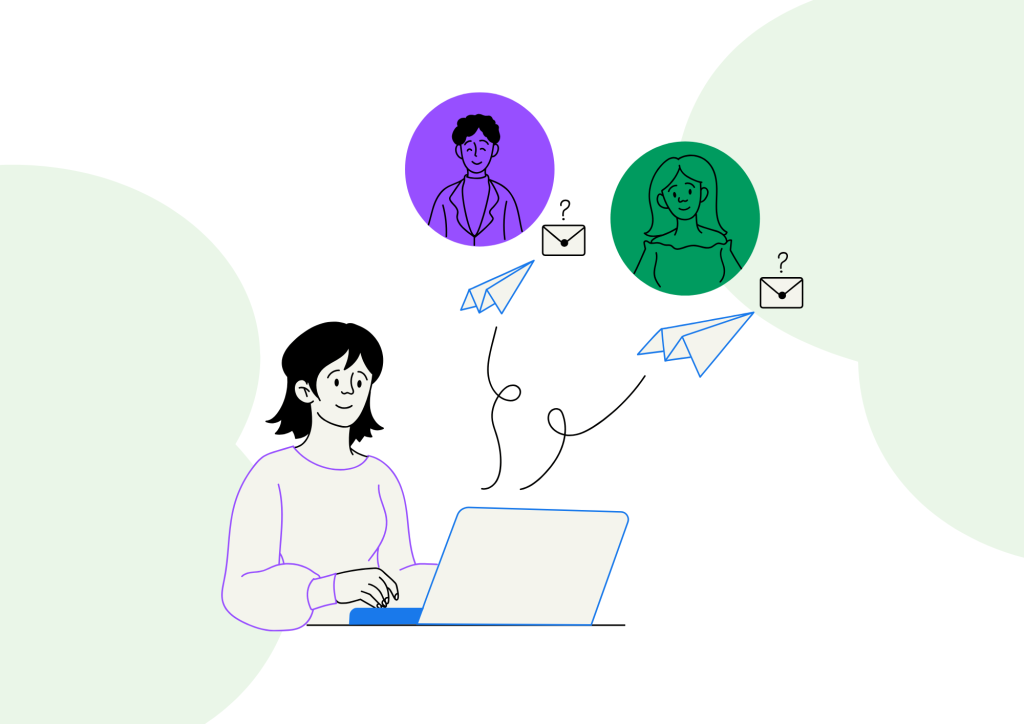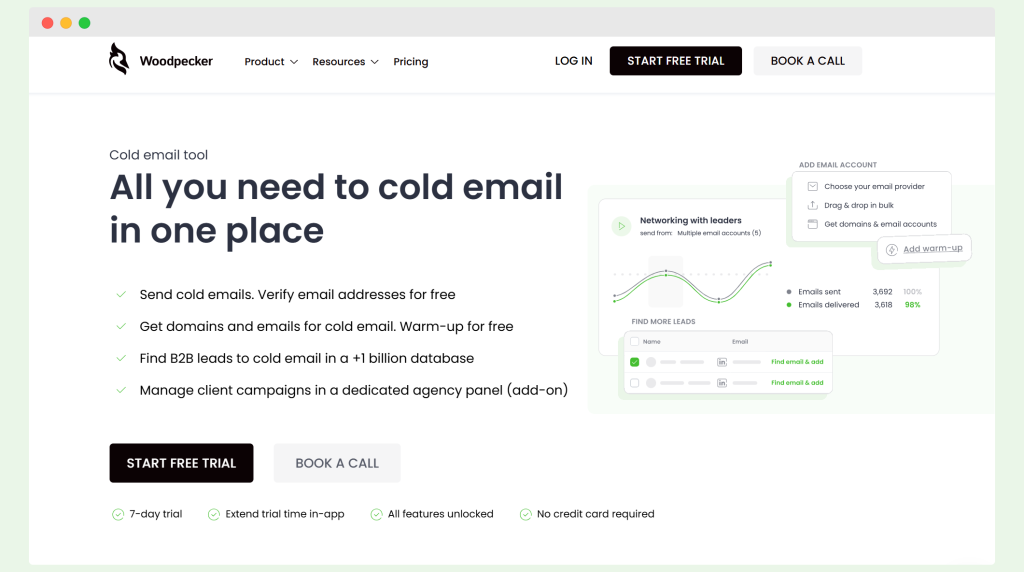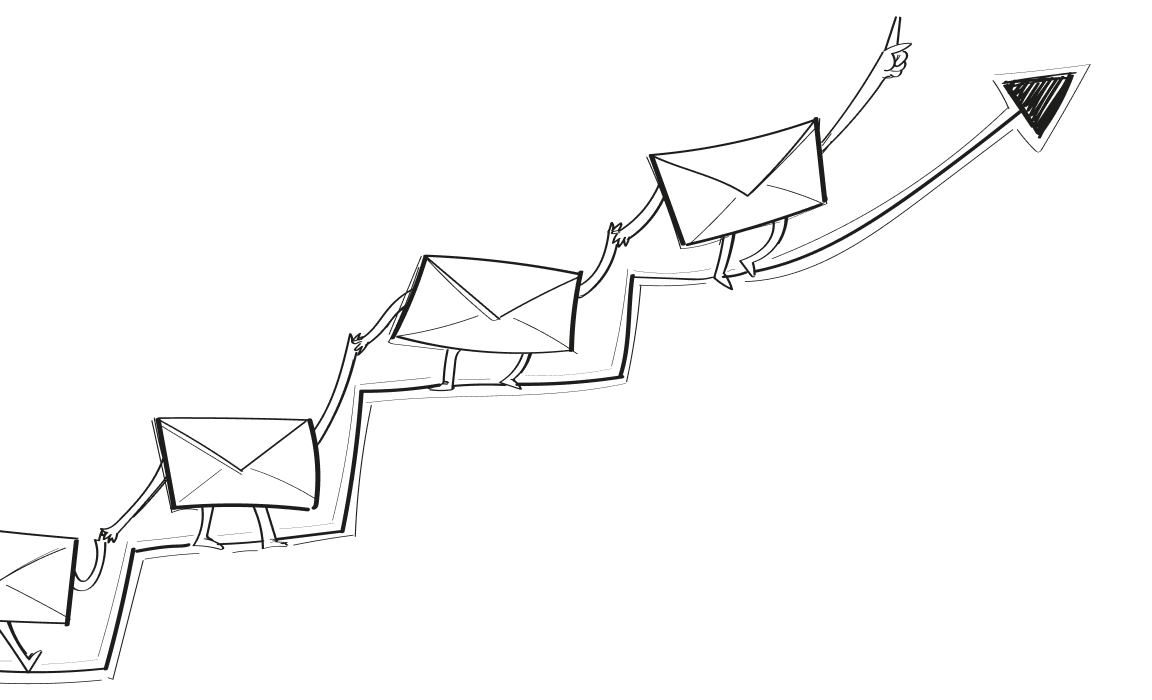You might think a single email ending up in the spam folder isn’t a big deal until it happens regularly. Surprising? It shouldn’t be.
When your emails fail to reach inboxes, it’s more than just a missed opportunity – it’s a direct hit to your sales, communication, and customer trust. Even the best marketing campaigns won’t connect with your audience without good email deliverability.
But here’s the good news: improving email deliverability isn’t impossible. By following a clear strategy, you can ensure your emails land in the right place at the right time, building stronger relationships with your audience and avoiding the spam folder.
This guide will walk you through the key steps, from cleaning your email list to authenticating your domain.
Ready to take control of your email performance?
Why does email deliverability matter?
Email deliverability ensures your message reaches the right people at the right time. If your emails don’t deliver and land in the spam folder, your chances of connecting with potential customers drop to zero.

Email deliverability refers to how successfully your emails make it to inboxes instead of being flagged as spam. This isn’t just a minor issue for a business—it’s a direct hit to your sales and communication efforts.
A poor sender reputation, caused by spam complaints or unverified email lists, can tank your email deliverability. Fewer people see your promotions, updates, or sales pitches, which in the real world translates to missed opportunities, lost sales, and reduced customer trust.
Email deliverability isn’t just a metric if you rely on email to drive engagement, build relationships, or close deals. It’s a lifeline for your business. Make sure your emails land where they’re supposed to, not in the spam folder.
How to improve email deliverability, step by step
Follow these simple steps to build trust with email providers, reach your target audience, and keep your campaigns performing at their best.

Authenticate your domain
Without email authentication protocols like SPF, DKIM, and DMARC, your emails might look suspicious to providers like Gmail or Outlook, even if you’re sending genuine content. A well-authenticated domain improves trust and ensures your emails reach your audience.
Think of it as giving your emails a trusted stamp of approval, proving they’re coming from you.
Here’s how to do it:
Step 1: Set up SPF (Sender Policy Framework)
SPF acts like a guest list for your email server. It tells email providers which servers are allowed to send emails on your behalf.
- Add an SPF record to your domain’s DNS settings.
- List the servers or email providers (like Gmail, Outlook, or Mailchimp) that can send emails from your domain.
With SPF in place, unauthorized servers pretending to be you will be flagged, improving email deliverability.
Step 2: Enable DKIM (Domain Keys identified mail)
DKIM adds a digital signature to your emails, proving they haven’t been tampered with in transit. It’s like sealing an envelope with wax—tampering will break the seal.
- Generate a DKIM key from your email service provider.
- Add the key to your DNS settings as a TXT record.
When email providers verify your DKIM signature, it boosts your sender reputation and keeps your emails out of the spam folder.
Step 3: Implement DMARC
DMARC (domain-based message authentication, reporting, and conformance) works with SPF and DKIM to give you control over how email providers handle unauthenticated messages.
- Create a DMARC record in your DNS settings.
- Set your policy to “monitor” first to see how unauthenticated emails are handled. Then switch to “quarantine” or “reject” as you gain confidence.
DMARC gives detailed reports showing who’s using your domain to send emails. It protects your brand and improves email deliverability by stopping phishing attempts.
Clean your email list
Sending emails to an unverified list wastes time, money, and effort. But the bigger issue? It damages your sender reputation, which directly affects your email deliverability.
Here are some key statistics to highlight the impact:
- 44% of businesses reported increases in hard bounces, emphasizing the need for regular list cleaning.
- 36% of respondents identified managing bounce rates and spam complaints as their top email hygiene challenge.
- 39.5% of businesses occasionally remove inactive subscribers to maintain list hygiene.
- Only 6.7% of businesses admitted they don’t actively maintain email hygiene.
- 29.2% of respondents noticed a decline in email deliverability in the last six months, often linked to poor email hygiene.
- Bounced emails over 10% are considered a serious issue, requiring immediate attention to avoid sender reputation damage.
- Cleaner email lists can increase open rates by up to 20% and reduce the likelihood of landing in spam folders.
- Experts recommend double opt-in and automated validation to reduce invalid addresses and improve list quality.
Surprised? Check out more in Bouncer’s hygiene list report.
Cleaning your list regularly ensures you’re reaching real people likely to engage with your emails.
So, how to clean your email list?
1. Identify invalid emails
Remove addresses that bounce, are no longer in use, or have typos (like *@gamil.com). Tools like Bouncer help you verify your list and filter out invalid entries quickly.
2. Remove unengaged contacts
If someone hasn’t opened your emails in months, they’re probably uninterested. Segment and remove these contacts to avoid wasting resources and hurting engagement rates.
3. Use double opt-in
Double opt-in ensures that subscribers confirm their email address when signing up. This reduces the chances of adding fake or incorrect addresses to your list.
4. Check your list regularly
Regular maintenance keeps your list fresh and ensures you target the right audience.
Whether running cold outreach campaigns with Woodpecker or maintaining a regular newsletter, a clean list ensures higher engagement and better results. The good news is that you can easily integrate Woodpecker with Bouncer.
Use a reputable ESP (email service provider)
Not all ESPs are created equal – using one with poor infrastructure or weak anti-spam measures can harm your sender reputation and push your emails into the spam folder. If your emails aren’t landing in inboxes, they’re not driving results—it’s as simple as that.
A trusted ESP improves email deliverability by ensuring your emails pass through the filters and into the inbox, not the spam folder.
How? By offering tools to manage sender reputation, authenticate your domain with SPF, DKIM, and DMARC, and monitor email metrics.
Here’s the reality: without the right ESP, your email campaigns will struggle. Poor infrastructure, low deliverability rates, or blacklisted IPs mean wasted time and missed opportunities.
Segment your audiences (based on preferences, geographic location, previous behavior, etc.)

Segmentation ensures your email campaigns resonate with your audience, improving engagement and your email delivery.
Here’s the secret: email providers reward engagement. When recipients open, click, or reply to your emails, it signals that you’re sending valuable content. The result? Better placement in inboxes, not the spam folder.
So, how do you segment effectively?
- Preferences. Let your audience tell you what they want. Whether it’s product updates, newsletters, or discounts – tailor your email campaigns accordingly.
- Geographic location. Timing matters. Send emails when your audience is awake and active. A midnight offer won’t get clicks if they’re asleep.
- Previous behavior. Track who opened past emails, clicked links, or made purchases. Use this data to target engaged users and re-engage those who went quiet.
- Demographics. Adjust messaging for different age groups, job roles, or industries to make your email marketing feel personal.
Segmenting your audiences makes your emails relevant, timely, and engaging—key ingredients for better email delivery. Stop sending one-size-fits-all emails and watch your deliverability (and results) climb.
Create personalized, engaging content
If you want your emails to dodge the spam folder and land in the inbox, content is everything. Mailbox providers use spam filters to protect users, and one poorly written email can send your entire campaign straight to spam.
Here are a few tips:
- Avoid spam trigger words. Words like “free,” “guarantee,” or “act now” can raise red flags for spam filters. Keep your language natural and aligned with your audience’s expectations.
- Write concise subject lines. Short, straightforward subject lines tell readers what to expect and encourage opens without looking suspicious.
- Make emails skimmable. Stick to short, well-organized content that’s easy to read on all devices, especially mobile. Busy readers won’t scroll through long, cluttered emails.
- Personalize your content. Use names, tailor messages to your audience’s interests, and make them feel like you’re speaking directly to them – not sending a generic blast.
Creating personalized, engaging content is much easier if you have the segmentation in place.
Check your sender reputation
Your sender reputation is like a report card for email marketers –it determines if your emails are delivered or discarded. If you’re serious about running a successful email marketing program, checking your sender reputation is non-negotiable.
Internet service providers (ISPs) monitor your email habits. They track bounce rates, spam complaints, and engagement to decide if you’re a trustworthy sender.
A solid sender reputation means your emails are more likely to land in inboxes, while a poor reputation can send them straight to spam.
To check your reputation, you can use tools like:
- Google Postmaster Tools: Helps you monitor your domain’s reputation and email performance.
- MxToolBox: Checks if your domain or IP address is on any blacklists.
- SenderScore: This gives you a score (like a credit rating) to show how ISPs see your sender reputation.
- GlockApps: Tests deliverability and helps identify issues with your sending habits.
Why does this matter? Blacklists are terrible for bulk email senders – they stop your emails from reaching anyone. If you discover your domain or IP address is blacklisted, take action immediately: identify what caused the issue, clean up your lists, and improve email hygiene.
Did you know that Woodpecker integrates with Bouncer? You can send your email list and have it clean without jumping between tools. No more invalid email addresses on your list.
Send email consistently

Sending emails at regular intervals helps set clear expectations with your audience. Regular newsletters or monthly updates show recipients – and email service providers – that you’re a reliable sender.
Irregular sending patterns can confuse recipients and trigger spam filters. Worse, going silent for too long and sending a sudden flood of emails can hurt your chances of maintaining high deliverability rates. When recipients don’t recognize your emails or forget that they signed up in the first place, they’re more likely to mark them as spam.
➡️ Decide how often to email your audience, and stick to it. Daily, weekly, or monthly – whatever works for your audience and content.
➡️ Monitor email performance metrics, such as open and click rates, to see how your schedule affects your recipients’ behavior.
➡️ With tools like Woodpecker, you can schedule your emails at precise intervals. Woodpecker even adjusts sending times based on engagement data, helping you avoid overwhelming your recipients.

Ready to take your email consistency to the next level? Try Woodpecker for seamless automation and better deliverability.
Don’t buy email lists
Buying email lists might seem like a shortcut to reaching more people easily, but it’s one of the fastest ways to damage your sender reputation. These lists are often riddled with hard bounces, invalid email addresses, and, worst of all – spam traps designed to catch bad senders.
When you send to these lists, you risk overwhelming your email domain with bounces, complaints, and low engagement. Internet service providers quickly flag this behavior, and your emails may end up in the spam folder – or blocked altogether.
Even if the addresses work, they’re usually irrelevant to your offer. Sending to uninterested recipients isn’t just ineffective – it’s harmful. A healthy, engaged list comes from genuine sign-ups, not shortcuts.
Test emails before sending
Testing your emails before sending them is crucial for avoiding mistakes that can damage your campaigns or lead to a lower sender reputation. A/B testing is one of the best ways to ensure your emails resonate with your audience.
With A/B testing, you can experiment with different subject lines, layouts, or calls to action to see what performs best.
For example, does a short, catchy subject line work better than a detailed one? Testing helps you send emails that engage recipients and avoid issues like low open or click rates, which can harm your sender reputation.
Tools like Woodpecker make A/B testing easy. You can test different versions of your email, compare results, and optimize your campaigns based on data, not guesswork.
Monitor key email metrics

Think your emails are doing fine? Maybe. But without checking your key email metrics, you’re guessing – and that’s risky when your inbox placement is on the line. The email metrics aren’t just numbers, they’re the pulse of your email campaigns.
If your open rates are low, your subject lines might not be pulling their weight. Or worse, your emails might be landing in spam folders. Click-through rates tell you if your content is engaging enough to make readers take action. And don’t ignore bounce rates – high numbers here mean you’re sending to invalid addresses, which can sink your deliverability fast.
More metrics worth tracking are conversion rate, spam complaint rate, unsubscribe rate, and inbox placement rates.
When these metrics drop, email providers question if you’re a trusted sender. That’s when your deliverability suffers. But the good news? Tracking these numbers gives you the power to fix what’s broken and improve your email deliverability at the right time.
Make it easy to unsubscribe
Nobody likes losing subscribers, but forcing people to stay on your list isn’t the answer. A difficult unsubscribe process can frustrate recipients and lead to spam complaints, which harm your sender reputation and email deliverability.
Make it simple, and include a clear unsubscribe link in every email, and let users opt out with just a click or two. Avoid requiring passwords or lengthy steps – respect your audience’s preferences. When unsubscribing is easy, people are less likely to mark your email as spam, keeping your sender reputation intact.
Comply with email laws, such as GDPR and CAN-SPAM
Breaking email laws can lead to fines and blacklistings that destroy your deliverability. Laws like GDPR and CAN-SPAM protect recipients, and following them builds trust with your audience.
So, how to stay compliant?
- Always get permission before sending emails.
- Include your physical address in every email.
- Provide a clear unsubscribe option.
- Avoid misleading subject lines or deceptive content.
Following these regulations shows recipients and email providers that you’re a responsible sender.
Take care of IP reputation and warm-up performance
Tracking the performance of your dedicated IP address is crucial, especially if you’re using a new IP address. This metric evaluates how well your IP is performing in terms of email delivery and engagement.
Email providers monitor IP reputation closely. If your new or dedicated IP sends too many emails too quickly without proper warm-up, it can get flagged, hurting your deliverability.
Monitoring this includes tracking delivery rates, bounce rates, and engagement from emails sent via the IP. A steady warm-up process, starting with smaller, engaged audiences, helps establish trust with email providers, ensuring your campaigns stay on track.
Conclusion: Take control of your email deliverability
Email deliverability is the key to connecting with your audience and driving results. By cleaning your list, authenticating your domain, and creating engaging content, you can ensure your emails land in inboxes, not to spam.
Want an easier way to get it done? Try Woodpecker. With features like email analysis, A/B testing, and smart scheduling, it’s your go-to tool for better email campaigns.
Start improving your deliverability today. Give Woodpecker a try!

